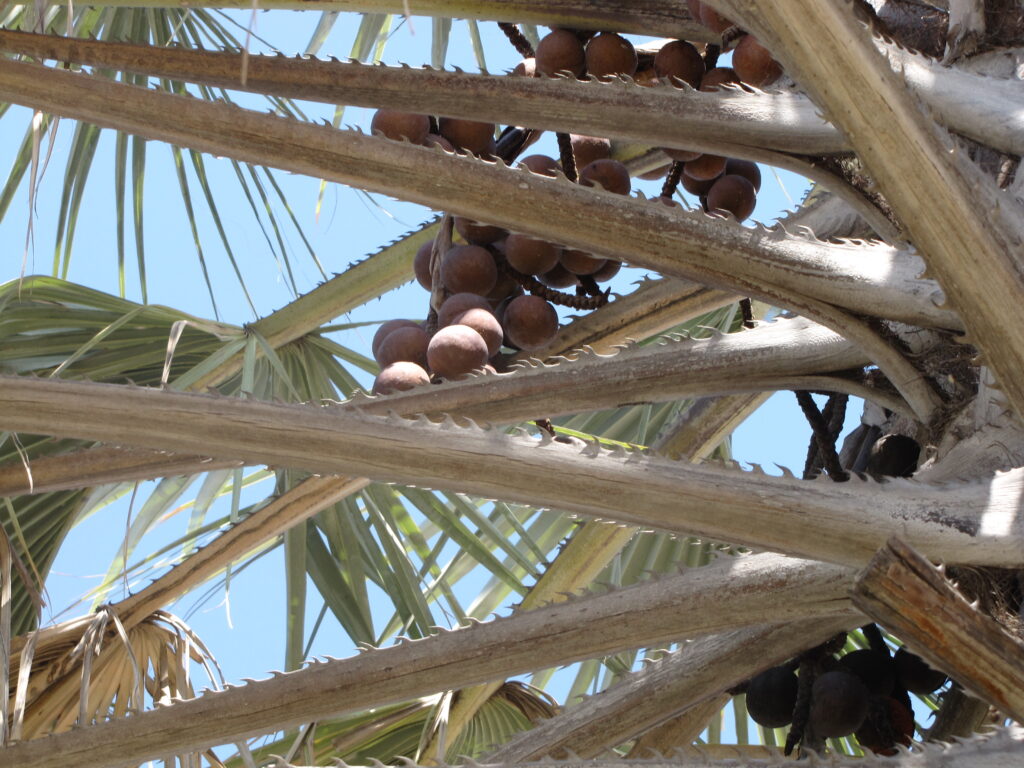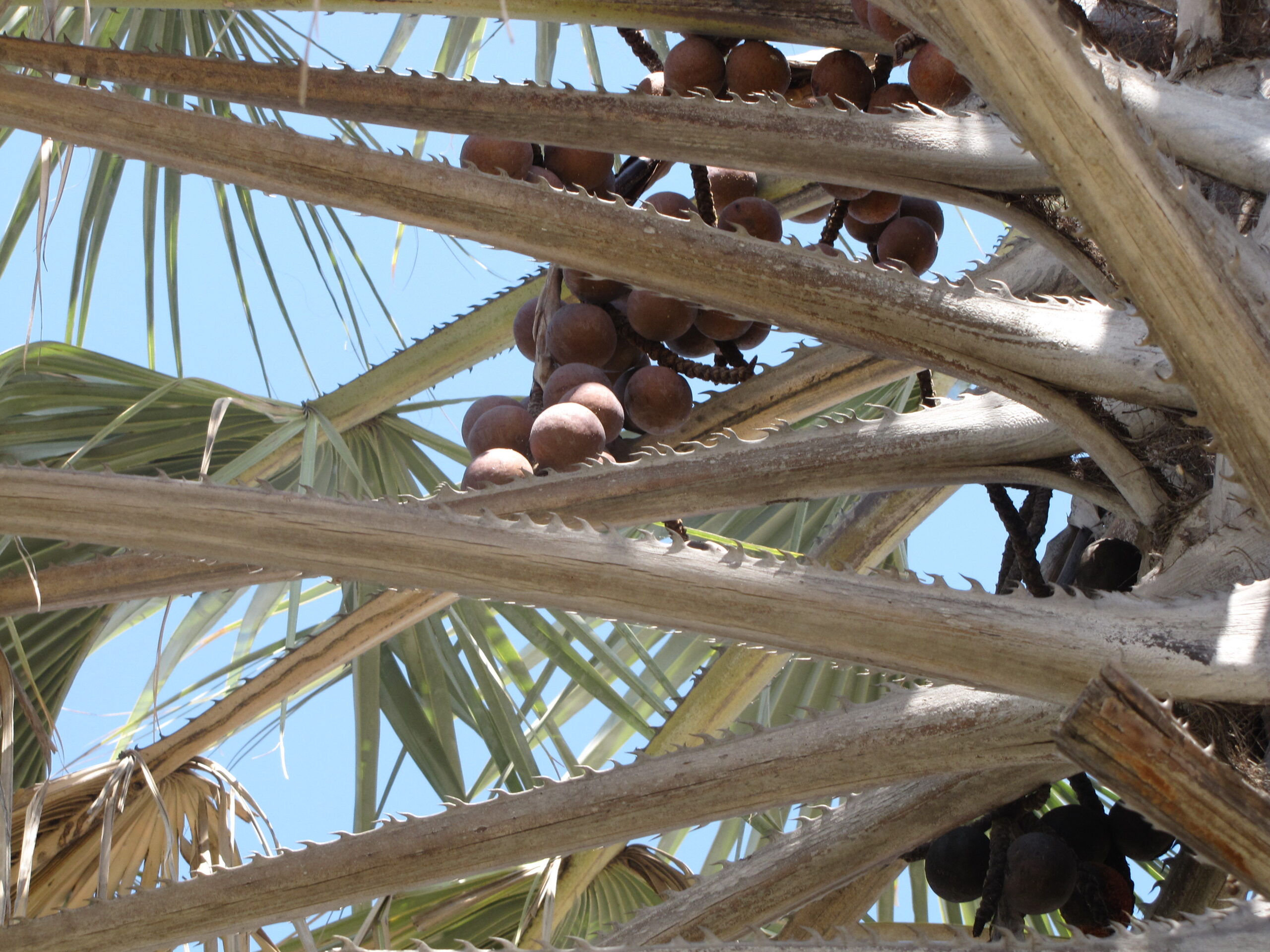By: David Crawford Jones (Ohio State University)
Originally Published 29 July 2016 [LINK TO ORIGINAL]
Standing tall against the blue skies and flat, limitless plains of northern Namibia, the Makalani palm tree has long been central to Ovambo culture, as a source of food and drink, in the weaving of baskets and the fashioning of cooking sticks, as well as the construction of fences that mark the boundaries of the region’s many homesteads.

But it is the curved and sturdy epokolo, studded with thorns and connecting the Makalani’s extremities with its trunk, that has played the most pivotal role in the region’s political history. Long used as a tool of corporal punishment by kings and headmen during the colonial era, in 1973 the epokolo sparked a scandal after dozens of political activists, including Charles Namoloh, the current Minister of Safety and Security, were beaten in public, prompting a legal case that generated international headlines and embarrassed the apartheid government on the world stage. That controversy would help bring an end to public flogging in Namibia, although the epokolo and its legacy continue to cast a long shadow over the region.
Among the hundreds of pages of testimony relating to the 1973 floggings, one can find Namoloh’s account of his own ordeal. On November 8, he was arrested by police officers working for the Kwanyama council of headmen in Ohangwena, after the officers noticed that Namoloh had sketched the colors of the Namibian flag onto his shirt. Viewing this as a provocation, the officers brought Namoloh before the headmen, who questioned the 23-year-old about his affiliation with SWAPO. After finding him guilty of being a SWAPO member, the headmen ordered that Namoloh receive 24 strokes of the epokolo, all of which were administered in front of a sizeable crowd. Namoloh explained in an affidavit, ‘I was flogged with my trousers on. I was flogged in full view of the public and the Tribal Police. The pain was unendurable and I screamed. The policeman administering the flogging did so with long pauses between the blows.’
Namoloh was one of several dozen activists flogged in 1973, in a concerted crackdown against SWAPO, which recently spearheaded a voter boycott of the elections for the Ovambo Legislative Assembly. When the apartheid government determined that it could not get convictions against SWAPO members in white courts, it decided to hand them over to the traditional authorities, who had considerably more leeway in punishing offenders given that the customary laws of the region were largely unwritten and frequently improvised on a case by case basis.

By publicly flogging Namoloh and his comrades, the traditional authorities hoped to shame the activists in front of their communities, thus discouraging them from engaging in further agitation. But in fact the floggings had the opposite effect, as the ranks of SWAPO and other anti-colonial organizations swelled in the aftermath of the beatings. As Johannes Nangutuuala, beaten in Ondangwa in October 1973, explained to a newspaper reporter following his punishment, ‘I am not unhappy about the flogging I received. In fact, I feel very happy about it because it was a great victory for me. First the authorities booted me into jail but this did not harm my political reputation. Then I was flogged and I benefited as a result.’ Sure enough, following an appeal from the Anglican and Lutheran churches seeking to put a stop to the beatings, in 1975 the S.A. Courts ruled against the traditional authorities, specifically prohibiting them from punishing politicians. In the wake of the court ruling, the institution of public corporal punishment declined and was finally ruled unconstitutional following Namibia’s independence in 1990.
Yet the epokolo was more than just a brief aberration in the history of northern Namibia, and its existence could not be attributed to the colonial presence alone. In their application to the court, the churches argued that flogging was a ‘white innovation’ brought into the region by the longtime administrator (1920-1946) of Ovamboland, C.H.L. ‘Cocky’ Hahn, known as ‘Shongola’ for his penchant for carrying, and occasionally using, a sjambok. But a decade before Hahn’s arrival in the region, the German missionary Herman Tönjes mentioned the ‘thorough beatings’ given to thieves, and even after the beginning of South African colonization, the kings and headmen of the region found in public flogging the ideal punishment for preserving their own power, frequently using the epokolo to punish a wide variety of offenses, from cattle theft and rape to men who impregnated young women outside of marriage.
In targeting criminals in this way, the kings and headmen were often supported by ordinary members of the community, who relished the opportunity to witness the punishment of young men who had violated communal norms. In a 2009 interview, the late Andreas Shipanga recalled witnessing in the 1950s the beating of a young man who had impregnated a girl but refused to take responsibility for the child. As he said, ‘The one case I witnessed, that boy was stupid and arrogant. He definitely needed to be flogged. The arrogance was too much. The little girl was in tears and he was talking [nonsense]. I felt it was good that he was flogged.’
Such memories have in recent years fueled a sense of nostalgia for corporal punishment among men and women who view prisons as a poor deterrent to crime in their communities. Commented one old man living in Okanjengendi, ‘Prison is useless because people will just go and eat nice food. They are even eating eggs and they have shelter and everything.’ Agreeing with that sentiment, a man from Onepungu, born in 1950, asserted that ‘The epokolo was good. People would watch and they were afraid. But now crime is high because there are no more omapokolo. If you just buy your sugar now, people will come and steal your sugar.’ In a country still experiencing high levels of poverty and unemployment, the epokolo continues to serve for some as a symbol of justice, more than 40 years after a younger generation of political activists faced its painful sting.
